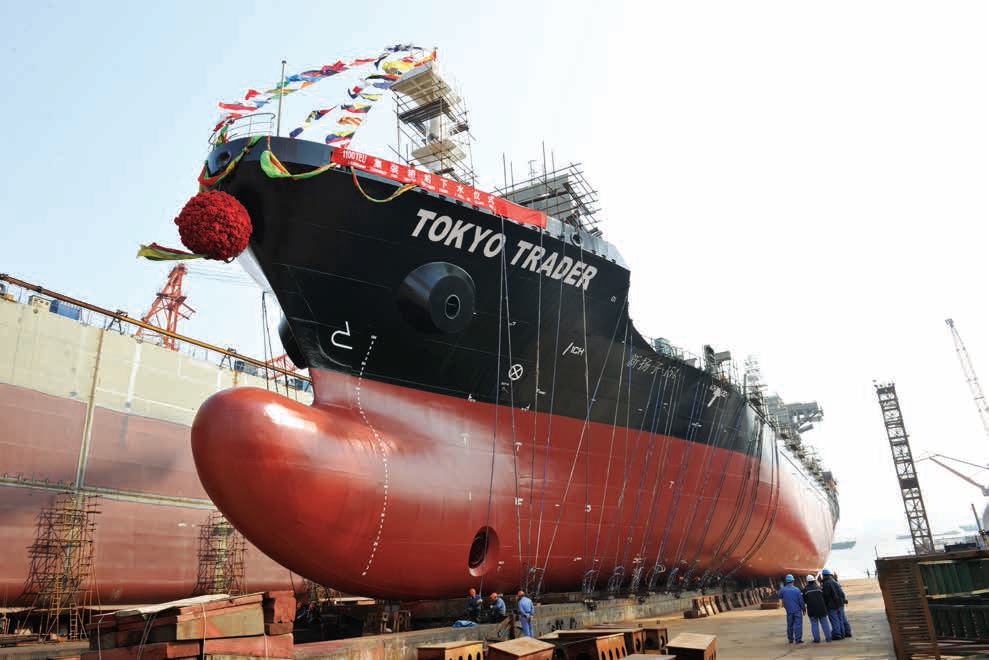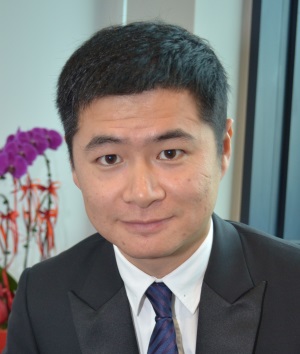 The shipbuilding market is tough, but there is demand for large containerships. Above: Tokyo Trader is a containership built by Yangzijiang for Maersk. Photo: Company
The shipbuilding market is tough, but there is demand for large containerships. Above: Tokyo Trader is a containership built by Yangzijiang for Maersk. Photo: Company
THE BOLD DECISION by Yangzijang Shipbuilding to invest in its shipyard capacity amidst a severe global shipbuilding downturn has proven sceptics wrong: Its 2QFY2015 revenue increased by 34% year-on-year to reach Rmb 5.7 billion, thanks to more shipbuilding activities made possible by the capacity increase at its Xinfu yard.
During FY2014, the Group had capital expenditure of some Rmb 1.4 billion, mainly for its Xinfu and Taicang shipyards.
This decision caused some investors to wonder if the new capacity could be filled, given the dearth of shipbuilding orders globally. In 2014, PRC shipyards managed to clinch only about one third of the orders they did for 2013. The PRC shipbuilding industry has taken an even harder hit this year: The drop in new orders for the first half of this year exceeded 70%.
Output lifts revenue
 CEO Ren Letian.
CEO Ren Letian.
NextInsight file photoYangzijiang's management had intended to invest in capacity so as to increase production output. The Group scheduled 11 vessels for delivery in 2QFY2015, compared to 9 vessels in 2QFY2014. The successful delivery of these vessels on schedule lifted 2QFY2015 shipbuilding revenue by 12% year-on-year to Rmb 3.76 billion.
“Our Xinfu yard is scheduled to operate at close to full capacity all the way into 2017. Having said that, our capacity can be also be increased by improving on efficiency,” said CEO Ren Letian at the Group’s results briefing on Wednesday morning at its office on Robinson Road.
More orders
Its Taicang yard has been repurposed from an offshore engineering facility to become a facility for installing tanks on clean energy vessels.
“We intend to build the Group’s growth on clean energy vessels, that is, LNG, LEG or LPG-fuelled vessels. We are likely to secure our first batch of clean energy vessel orders in the third quarter,” said Executive Chairman Ren Yuanlin, who was also present at the meeting.
 "We expect to deliver our one and only offshore engineering structure --- the Super 116E jackup platform on schedule by this year. We have established a reputation for our capability in offshore engineering.
"We expect to deliver our one and only offshore engineering structure --- the Super 116E jackup platform on schedule by this year. We have established a reputation for our capability in offshore engineering.
"Construction of oil rigs is a viable business only if oil price is at US$70 a barrel or more. In the meantime, clean energy vessels will replace our offshore engineering business," said Executive Chairman Ren Yuanlin.
NextInsight file photo
In addition, the Group secured another US$510 million worth of orders in July and August, comprising of four 3,800 TEU and four 9,700 TEU containerships, each with options for four more vessels. Including orders for 10 vessels secured in 1HFY2015, a total of 14 vessels with 8 options to be exercised this year were added to the order book year-to-date.
As of 30 June 2015, the Group had an outstanding order book of US$4.14 billion, comprising of 102 vessels. This included US$25.4 million for converting existing orders for 9 bulk carriers into containerships.
Margin headwinds
Gross profit margin decreased by 9.7 percentage points to reach 18%. The Group had revised its contract prices downward to reflect the competitive pricing in the market. Accordingly, net profit attributable to shareholders decreased by 17% to Rmb 1.0 billion.
Below is a summary of questions raised at the meeting, and the replies provided by the Chairman, the CEO and CFO Liu Hua.
Q: What are the demand and price trends in containership and dry bulk carriers?
Ren Yuanlin: During the first half of 2015, orders for the entire PRC shipbuilding industry fell by 70% to 80% year-on-year. The reason for this is PRC shipyards specialise in dry bulk carriers, and there was practically no order for dry bulk carriers during the first half of this year.
There is stronger demand for large containerships and larger oil tankers, but this market was dominated by South Korean and Japanese yards. The Group doesn’t have a price advantage against South Korea yards like Samsung and Hyundai in the construction of large containerships. Some Japanese yards secured some orders because of the depreciation of the Japanese Yen.
 CFO Liu Hua.
CFO Liu Hua.
NextInsight file photoOur previous strategy of minimum contract value and margin is no longer working. We need to set our prices by referring to trends set by Japanese yards, Korean yards and other PRC yards. If we let go of some profit margin, we are still competitive compared to Japanese and Korean yards. Having said that, we will not accept orders that are loss-making. I doubt if prices of vessels will increase significantly over the next few years. But we are confident of securing a strong order flow.
Before May, we too did not see much orders. In June, we changed our strategy to prioritise the securing of orders over margins. This enabled us to secure a significant amount of orders after May.
Q: Can you maintain your revenue if you accept orders with reduced contract values?
If the RMB exchange rate remains stable, we can maintain our revenue. However, if the RMB appreciates extensively, top line may be affected.
Q: Do you hedge against the appreciation of the RMB?
Liu Hua: We have an order book that lasts about 24 months. So, we use currency derivatives to hedge our currency exposure for a duration of 12 to 24 months. Our average hedging level for the RMB/USD is at 6.55 (current market value is 6.02). During 2QFY2015, we had a nice foreign exchange gain of RMB 155.3 million.






